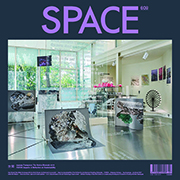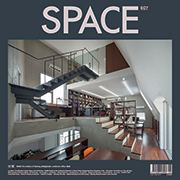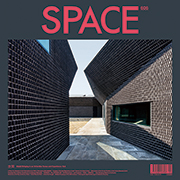The 34th Space Prize for International Students of Architecture Design
- Architecture in a Precarious World -
SUBJECT
Architecture in a Precarious World
The global pandemic has exacerbated the ongoing social, economic, and ecological crisis; a world of extreme precariousness that has grown increasingly widespread over the last few decades. Its effects are well-known, from massive income and social inequality to sea level rise, catastrophic flooding, and increasingly powerful hurricanes and wildfires. The early 21st century is defined by omnipresent fragility. More recently, economic and social changes are becoming increasingly apparent. The term “precariat” (precarious proletariat) has been coined to describe the urgent problem of the unstable conditions of a new class of workers lacking predictability and security. This accumulation of crisis, with its magnitude so vast, complex, and varied, demands definitive action and change. Perhaps one positive aspect of this pervasive condition is that we are confronted with endless numbers of issues and compromised sites all around us which we can immediately reassess and upon which we can begin to develop strategies of intervention. In response to these acute changes, we are forced to grapple with fundamental questions: Is architecture a relevant tool for addressing such a precarious world? If so, how might it be used to respond to these overwhelming challenges?
This competition is a call to broadly survey and identify various fragile sites, precarious social and ecological conditions, that urgently need to be addressed and cared for while seeking alternative approaches to resilience through design. It is also an appeal to imagine new forms of commons that, in turn, could inspire a hopeful and bold new path for future architects.
JURY REPORT
Minsuk Cho, Anthony Fontenot
The initial impression of this year’s submissions for the 34th Space Prize was the substantial number of high-caliber proposals. In Stage 1, the jury found more than half of the 80 proposals to be valid and intriguing, leading to a lengthy and lively discussion between the two jury members to select the 15 finalist teams. Many of the projects presented an engaged “process of discovery,” which is crucial to identifying a precarious condition, instead of merely imposing an “inventive intervention” architecturally. Many presentations revealed a serious understanding of their site, the specific causes of a precarious state, and an intelligent utilization of the strategies and methods suggested by the competition brief toward finding a solution to distinct conditions within the emerging context of cultural ecologies and natural ecologies of the 21st century. The top 5 selections exemplify an awareness of the wide range of urgent concerns confronting contemporary culture, locally, globally, in the urban context, and in the grand scale of nature. Clearly organized thoughts and astute observations are demonstrated through research-based analysis and findings which were successfully translated into uniquely insightful architectural responses that aim to both prevent and find resolutions to our precarious world.
GRAND PRIZE

LEE, KEON HEE + KIM, JIN KU + YOON, WON SIK
Chung-Ang University
Toward an Alternative Nature
 Intended experiences, loss of the natural
Intended experiences, loss of the natural
In the modern era, urban and architectural spaces have evolved with the logic of capitalism and the yearn for efficiency. The algorithm ghetto and thus following linear and biased consumption of space leads to a acceleration of inequality.
Alternative Nature
In the city where all things are commercialized and blanks are filled. We have found a possibility within the undeveloped neighborhoods. These houses are accumulated through anonymous alterations and are untouched by the grasp of capitalism. Thus created diverse environments provide a somewhat natural experience. We would like to this an “Alternative Nature”
A contemporary intervention_(Palimpsest, Frame)
we would like to preserve this alternative nature through a contemporary intervention, therefore continuing and reinforcing it. the intervention consists of platforms and circulations allowing diverse programs to take place. Our intervention is a addition, a new layer, a contemporary adjustment and a transitional space between the public and private.
A new esplanade_(Folly)
Our proposed intervention will newly project the accumulated past and allow us to rethink its purpose. someday this intervention will face development in the frontline for nature. these interventions stacked with the memories of the collective will stay and bring change.
Jury’s comment
This project pays close attention to a particular low-rise multi-unit residential building typology and the specific urban context created by it. In the near future, this unique area is potentially in a precarious state of either becoming another site of tabula rasa redevelopment for high-rise projects or a “Bukchon-like” gentrified theme park of nostalgic fetishization. It successfully avoids these scenarios and suggests an alternative that is both pragmatic and poetic. The project is distinguished by its careful observation and understanding of the urban context demonstrated through intense, hyper-detailed documentation of existing architectural elements that results in particular social conditions. In response, the proposal consists of a comprehensive lightweight structural system that adds generous and flexible spaces, vertically and horizontally, that allow urban/architectural spaces to expand into new types of outdoor social spaces while maintaining the desirable qualities of the existing city fabric.
PRIZE OF EXCELLENCE

HONG, JIN WON
LEE, HAK HYEON
Ajou University
Rebalancing Scale
 Based on the functionality of the Earth, the cycle of nature has formed a suitable shape over a long period of time, and mankind has just joined as a small fragment. However, it was questionable whether it was right for mankind to exert influence as a major subject on the global ecological cycle of change that took place only a few centuries ago. What is clear is that the civilization activities we have achieved in just a short period of time have produced a lot of climate change, which implies uncertainty in extent and size.
Therefore, this project aroused the seriousness of the climate crisis as a side effect on subjective human behavior and attempted to find a recovery balance point in the size of the natural ecosystem away from the size of mankind that has grown too large. In addition, it was approached as an exploration of how human beings can intervene in the environment as a part of nature.
Among the many climatic changes, we paid attention to the rising sea level, which is approaching as a real threat to all countries facing the sea. The mudflat, Korea's unique natural treasure, was used as an indicator of wounds and recovery, and was viewed as a key factor in reducing the power of ocean currents. Sihwa Lake, the target site, has been expanding its area for a long time, with birds, fish, microalgae, and benthic animals forming organic relationships around the mudflats. However, in recent decades, the Sihwa Lake ecosystem has led to the collapse and loss of natural ecosystem cycle structure due to direct or indirect human intervention, and the function of the mud flat has decreased. Therefore, considering the changed context, we think that helping rebuild the natural habitat of each ecosystem with minimal intervention can be a flexible response to the recovery of nature and, furthermore, sea level rise.
Based on the functionality of the Earth, the cycle of nature has formed a suitable shape over a long period of time, and mankind has just joined as a small fragment. However, it was questionable whether it was right for mankind to exert influence as a major subject on the global ecological cycle of change that took place only a few centuries ago. What is clear is that the civilization activities we have achieved in just a short period of time have produced a lot of climate change, which implies uncertainty in extent and size.
Therefore, this project aroused the seriousness of the climate crisis as a side effect on subjective human behavior and attempted to find a recovery balance point in the size of the natural ecosystem away from the size of mankind that has grown too large. In addition, it was approached as an exploration of how human beings can intervene in the environment as a part of nature.
Among the many climatic changes, we paid attention to the rising sea level, which is approaching as a real threat to all countries facing the sea. The mudflat, Korea's unique natural treasure, was used as an indicator of wounds and recovery, and was viewed as a key factor in reducing the power of ocean currents. Sihwa Lake, the target site, has been expanding its area for a long time, with birds, fish, microalgae, and benthic animals forming organic relationships around the mudflats. However, in recent decades, the Sihwa Lake ecosystem has led to the collapse and loss of natural ecosystem cycle structure due to direct or indirect human intervention, and the function of the mud flat has decreased. Therefore, considering the changed context, we think that helping rebuild the natural habitat of each ecosystem with minimal intervention can be a flexible response to the recovery of nature and, furthermore, sea level rise.
Jury’s comment
The proposal is situated amongst the ecologically precarious condition of Sihwa Lake, located on the western coast of Seoul City and to the south of Incheon Airport, a body of water continuously threatened by human interventions. Strategically located in the specific area of the lake where seawater and freshwater meet, the project aims to reestablish ecological equilibrium through the combination of water flow from ocean currents and an “ecological breakwater” accompanied by a series of floating wetland systems anchored in place. These new elements become the basis for increasing biodiversity with the aim of allowing the territory to flourish ecologically. The breakwaters are built using “tetra ball” forms to create clusters, resulting in a rhizome-like structural network used as breakwater which provides areas for new forms of habitat. Underwater vertical clusters allow for the cultivation of algae for bioenergy while creating habitats for marine ecosystems to thrive. The jury was impressed by the large-scale ambition of the intervention and the attention to detail of a complex multidisciplinary research displayed throughout the proposal
SPECIAL PRIZE
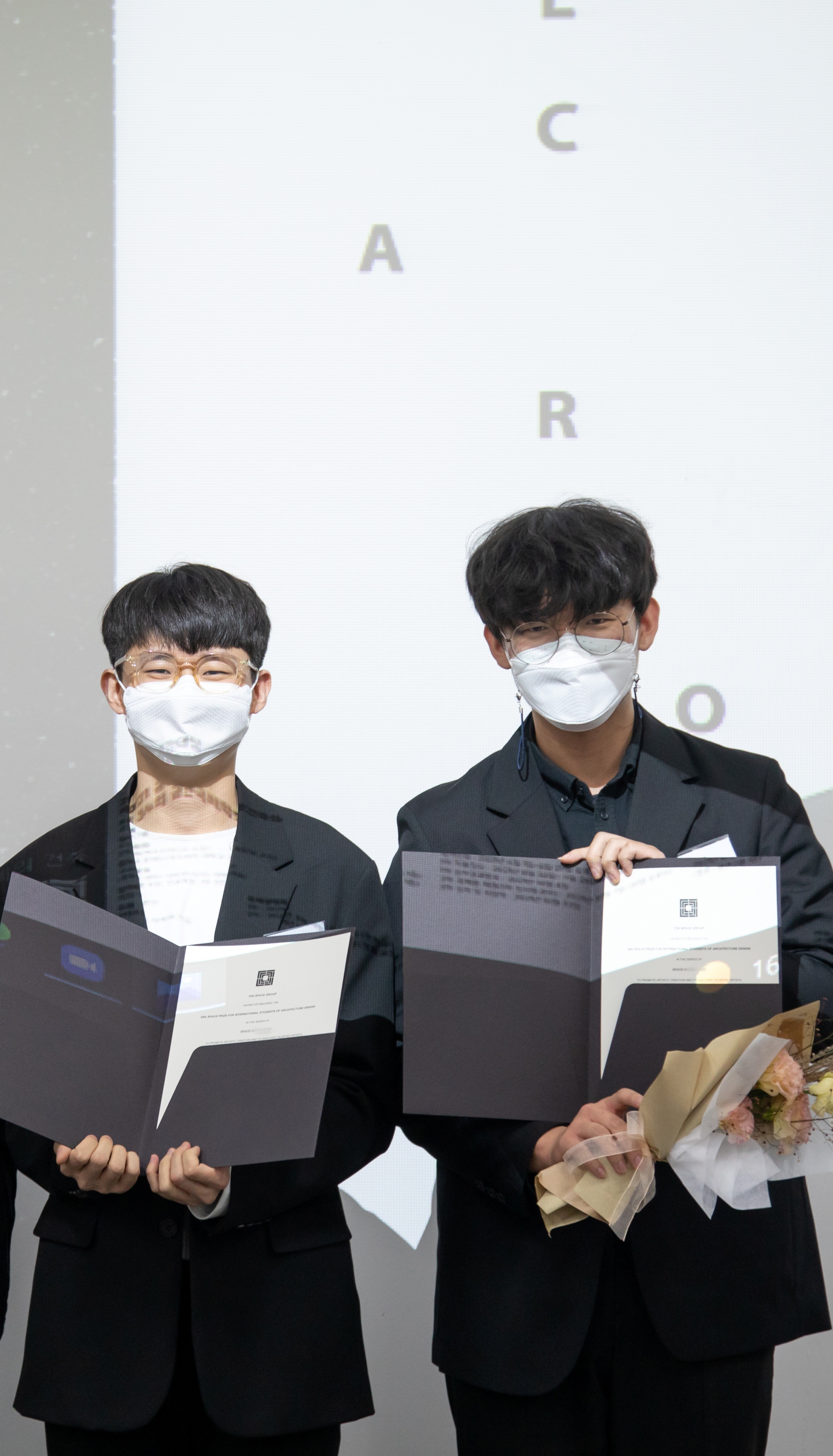
HWANG, HAE SEUNG
NA, KYEONG JUN
Sahmyook University + Hanyang University ERICA
Vuffer
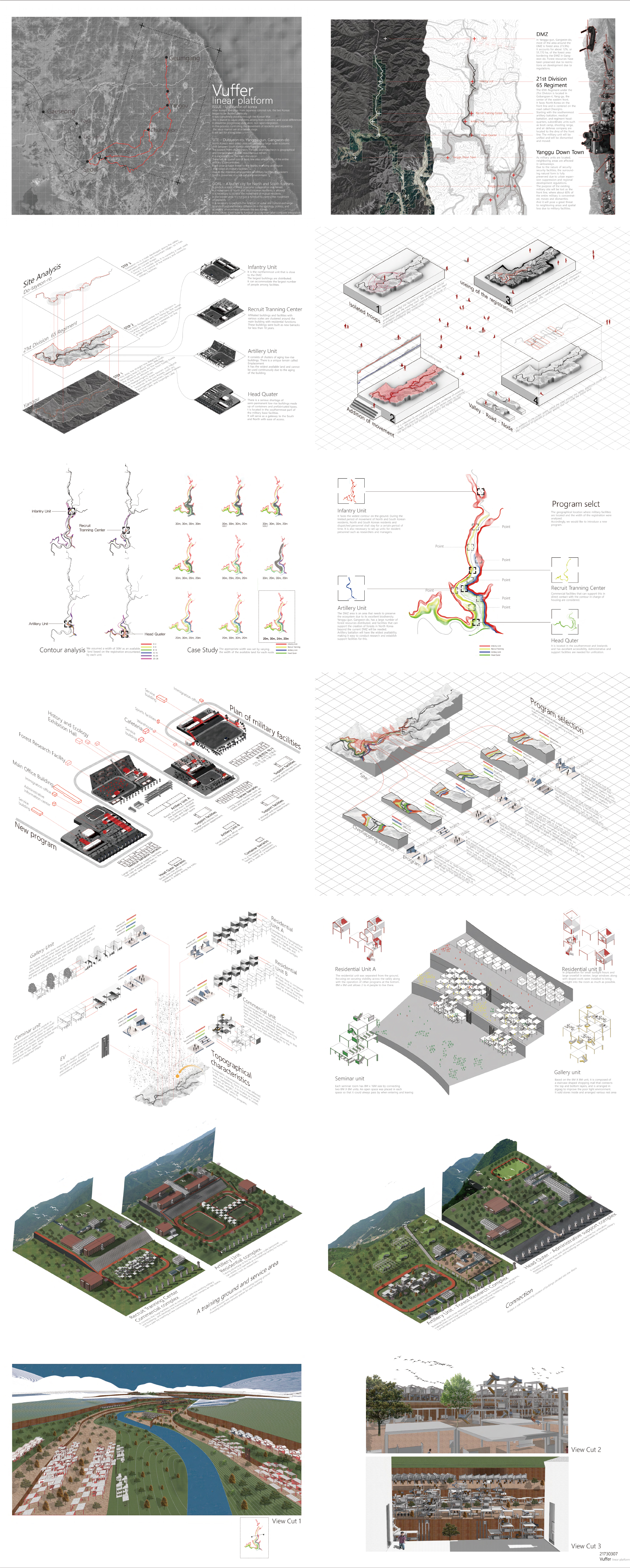 After the division, discussions on the ultimate peaceful unification have been made through cooperation between the North and South Korea. in various ways.
If rapid integration proceeds, various social problems are feared to arise.
While achieving economic and social integration by gradually increasing exchanges and cooperation with North Korea, it is necessary to ultimately achieve unification through political integration.
It predicts a state in which economic cooperation is achieved, but movement of North and South Korean residents is allowed.
North Korea's west coast cities are expected to proceed in the direction of benefiting from the developed industrial capabilities and infrastructure of South Korea's metropolitan area and develop adjacent Ganghwa, Incheon, and Pocheon areas.
In contrast, the eastern regions of Cheorwon, Yanggu, and Hwacheon are excluded from the main discussions due to their rugged mountainous terrain.
In the Dutayeon area of Yang-gu, the straight line to Geumgang-eup is about 39km, and both the distance and time are the shortest, so it can be connected from South Korea to Naegeumgang River in reality.
In addition, the purpose of the existing military site will be lost as the movement and dismantling of the front line, where about 60% of the entire military is concentrated. It will have a great impact on neighboring areas that depend on military units.
In place of the spatial loss of military units that had their respective properties, the path connecting them with each of the four military units, and the registration to be located are analyzed to give different characteristics to each.
The complex distributed around the valley path will serve as a platform that can buffer the residents of the North and South Korea.
After the division, discussions on the ultimate peaceful unification have been made through cooperation between the North and South Korea. in various ways.
If rapid integration proceeds, various social problems are feared to arise.
While achieving economic and social integration by gradually increasing exchanges and cooperation with North Korea, it is necessary to ultimately achieve unification through political integration.
It predicts a state in which economic cooperation is achieved, but movement of North and South Korean residents is allowed.
North Korea's west coast cities are expected to proceed in the direction of benefiting from the developed industrial capabilities and infrastructure of South Korea's metropolitan area and develop adjacent Ganghwa, Incheon, and Pocheon areas.
In contrast, the eastern regions of Cheorwon, Yanggu, and Hwacheon are excluded from the main discussions due to their rugged mountainous terrain.
In the Dutayeon area of Yang-gu, the straight line to Geumgang-eup is about 39km, and both the distance and time are the shortest, so it can be connected from South Korea to Naegeumgang River in reality.
In addition, the purpose of the existing military site will be lost as the movement and dismantling of the front line, where about 60% of the entire military is concentrated. It will have a great impact on neighboring areas that depend on military units.
In place of the spatial loss of military units that had their respective properties, the path connecting them with each of the four military units, and the registration to be located are analyzed to give different characteristics to each.
The complex distributed around the valley path will serve as a platform that can buffer the residents of the North and South Korea.
Jury’s comment
This project successfully considers a precarious topographic territory of the Korean Demilitarized Zone (DMZ) that is typically inaccessible. There is an urgent demand to rethink the future development of these areas as part of a cultural process of unification. The specific site of intervention is a linear military facility along the border, which is systematically studied in detail, displaying a near-forensic manner of investigation. The proposal is largely based on a series of small-scale modular buildings which complements the existing large-scale military facility buildings of the site. It employs a relevant strategy of implementing minimal new forms of architecture to mitigate between what exists and what might evolve as a new urban form in a process of unification. The project inspires new ways of thinking about this and other “tragic sites” in the area that may one day become part of a “process of recovery,” as opposed to the current, long-frozen stifled situation. The jury was impressed with the vision and ambition of the project which uses architecture and urbanism in a new way to consider socio-political issues and ecology as well as providing spaces for the coexistence of human and non-human agents.
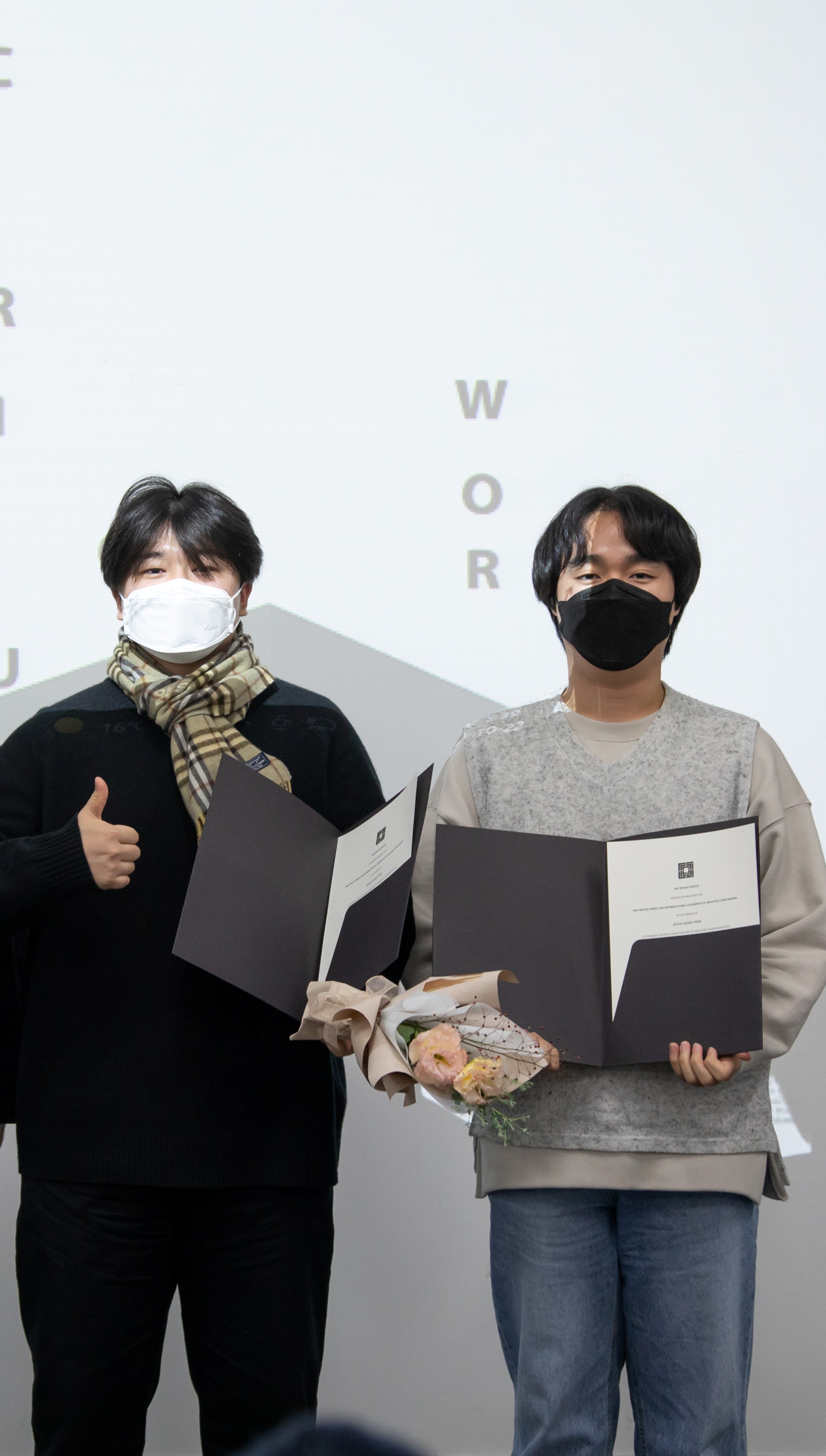
PARK, JI WON
CHOI, DAE JUN
Kangwon National University
Deus Ex Machina
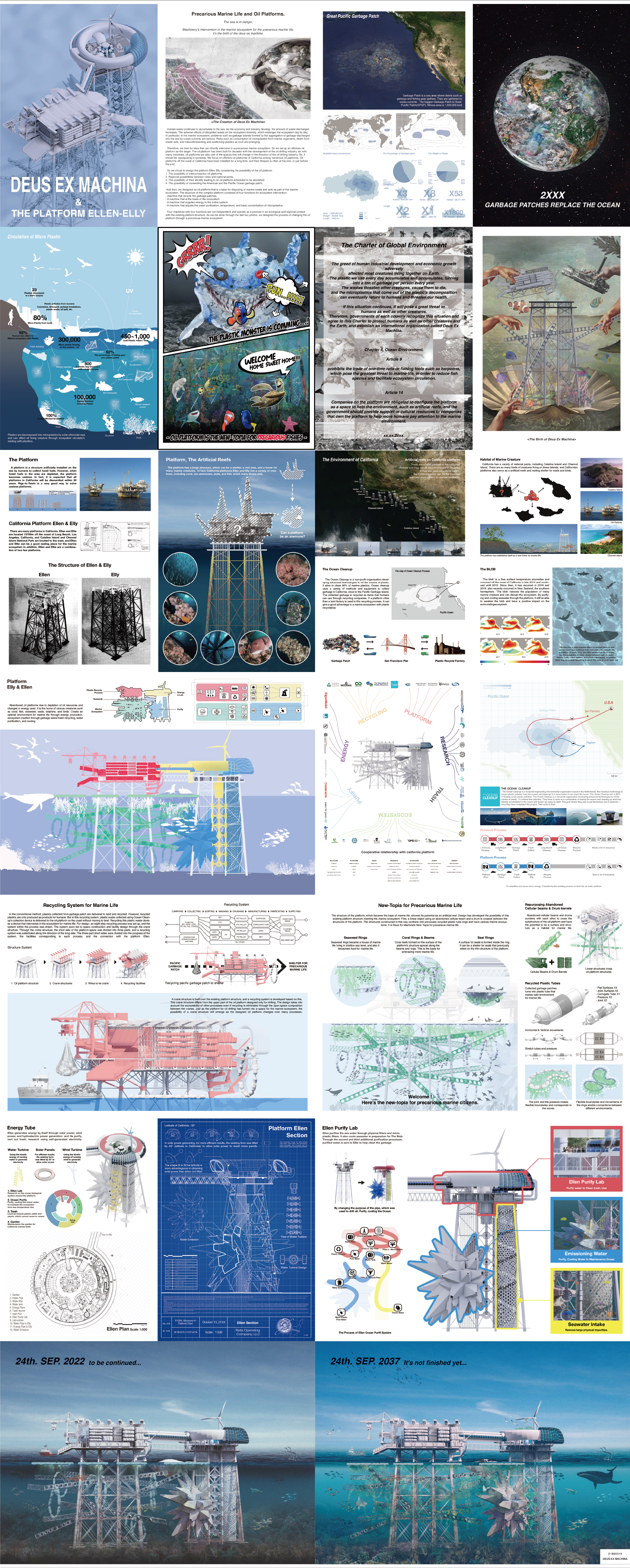 Our oceans are under threat. Human-made wastes have been gathering through the sea current, forming the great garbage patch and threatening sea lives. Accumulated wastes and microplastics are ruining the marine ecosystem and endangering human lives eventually. The situation is complex, like tangled fishnets. We, therefore, look for sites that can directly intervene in a vulnerable marine ecosystem. It can be Deus Ex Machina: Restructuring offshore oil platform.
Our oceans are under threat. Human-made wastes have been gathering through the sea current, forming the great garbage patch and threatening sea lives. Accumulated wastes and microplastics are ruining the marine ecosystem and endangering human lives eventually. The situation is complex, like tangled fishnets. We, therefore, look for sites that can directly intervene in a vulnerable marine ecosystem. It can be Deus Ex Machina: Restructuring offshore oil platform.
To combat the problem, we target an offshore oil platform. The oil rigs have been built to drill wells in the ocean bed, extract oil, process the fluids, and ship them to shore. Shortly, these offshore drilling will be at the end of their working lives and be abanded, along with the growing concern of environmental issues. The platforms whose life span is about to end should be the target of repurposing someday. We focus on the offshore oil platforms, Ellen Elly, off the coast of California as a "place to intervene in marine ecosystems."
Designing the platform, Ellen Elly has the following possibilities:
1. Establishing the base for collecting garbage connecting North America and the Great Pacific garbage patch
2. Creating the ocean ecosystem located between the cities and national marine sanctuaries
3. Providing complex programs through the connection of two platforms
4. Expanding the restructuring of other offshore oil platforms off the California coast
With these possibilities, we designed an oil platform that can be both the base for collecting and treating marine waste and the facilities for the marine ecosystem. The structure of a complex platform consists of the following four following functions:
1. A machine treating and recycling garbage patches
2. A machine adjusting the water purification, temperature, and base concentration of microplastics
3. A machine supplying energy to the entire system
4. A machine that can be the basis of the marine ecosystem
The above four machines with four functions are not separate from one another. Still, they operate in an ecological and regional context with the existing platform structure. We designed the process as a place of change while responding to the perils of the present. The device for the coexistence of marine ecosystems, Deus Ex Machina, will operate through this newly-designed oil platform.
Jury’s comment
The project is based on the observation that abandoned oil platforms serve as habitat for various creatures such as coral, fish, seaweed, seals, dolphins, and birds. The proposal consists of transforming an abandoned platform into a new “ecological machine” equipped with the capacity to recycle ocean garbage, generate sustainable forms of energy, increase biodiversity through the creation of new habitats and help purify ocean waters. The jury was excited by the strategy of appropriating a 20th century carbon-intensive infrastructure and its conversion into a 21st century post-carbon facility to help mitigate various ongoing devastating environmental conditions.
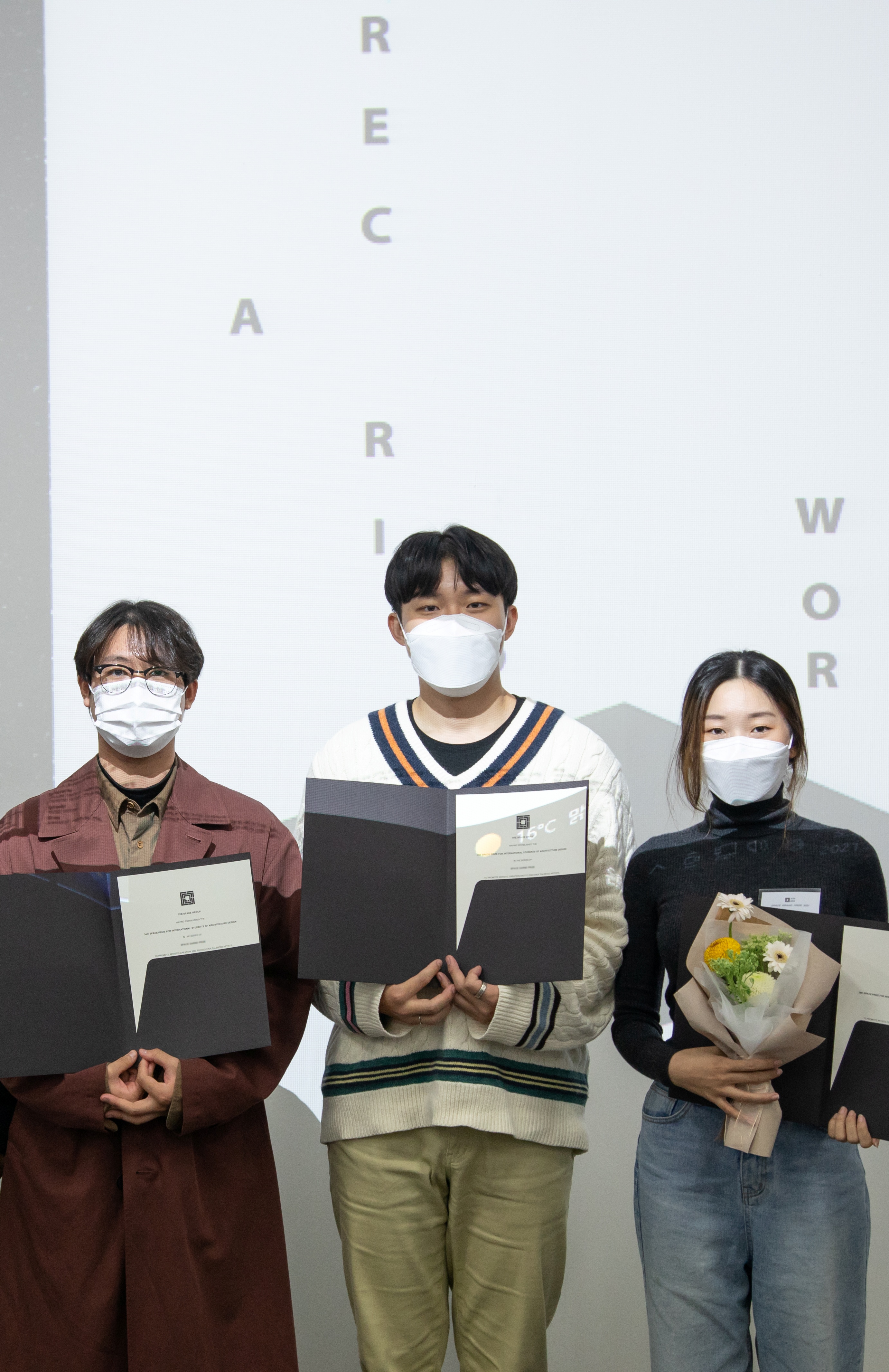
KO, KYU MIN
KIM, YEH SOL
PARK, SE JIN
Hanyang University Graduate School + Hanyang University ERICA + Hanyang University ERICA
New Noah's Ark
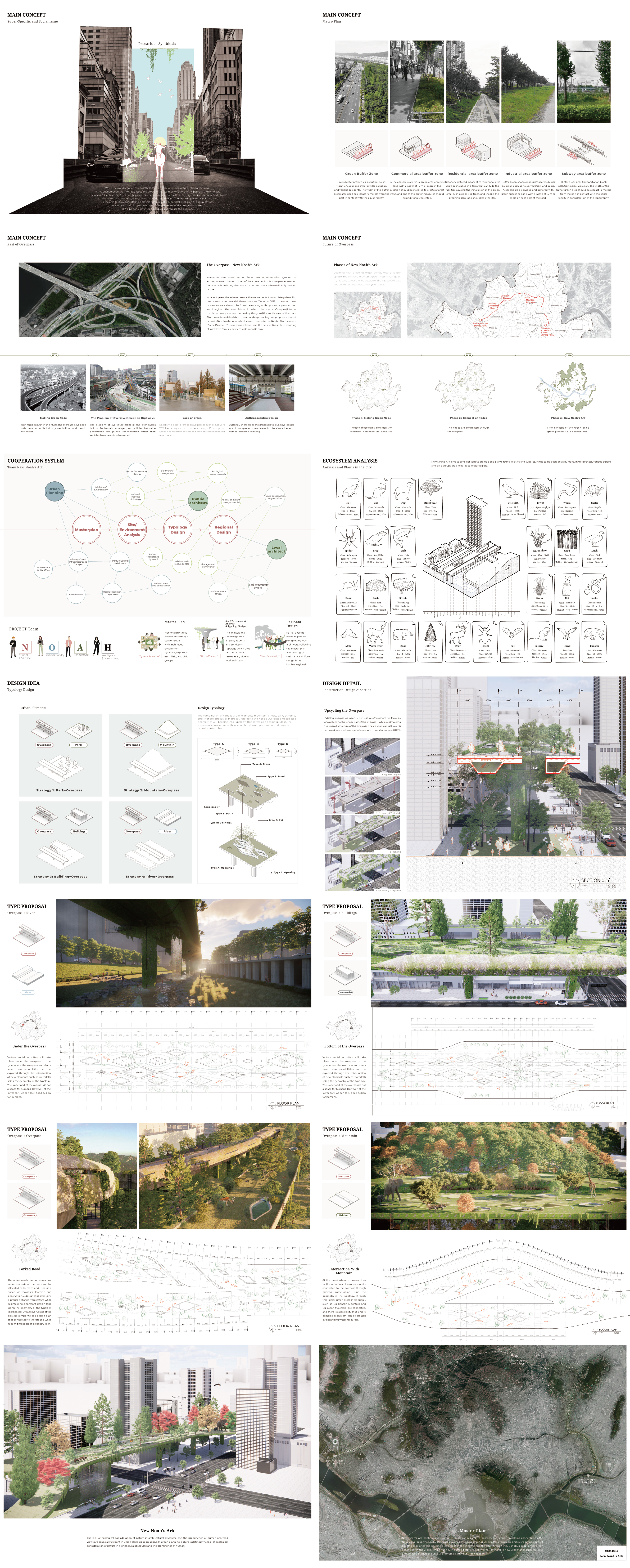 What is a way to give subjectivity to the 'ecosystem' in architecture?
The project
What is a way to give subjectivity to the 'ecosystem' in architecture?
The project
Jury’s comment
The project is based on careful and detailed observations of the precarious condition of various wild animals within the urban territory of Seoul. While considering alternative strategies for the elevated Naebu Beltway (내부순환도로), the proposal transforms it into an “elevated green belt” for non-human agents. The conceptual strategy of appropriating a massive expressway network, designed for carbon fuel consumption of the private automobile, and its transformation into a “biodiverse expressway” for animals in the city is provocative. The project proposes an alternative strategy for thinking about the future of outmoded urban infrastructures that is neither based on the Cheonggyecheon Stream in Seoul nor the High Line in New York. It is another brilliant, entry example of how a generic, large-scale 20th century carbon intensive form of urban infrastructure can be converted into a 21st century post-carbon entity in an ambitious, imaginative, yet locally responsive way.
SELECTED WORKS

CHO, JU EUN
WON, JI JEONG
JEONG, EUN ME
Hanyang University
OBLIQUE STREET


AN, SEONG HYE
SHIN, JUNG YEON
Kookmin University
Shapes of material


HWANG, HEE SU
JUNG, MOON SEOK
PARK, JUN HWI
Pusan National University
Separate; to Coexist

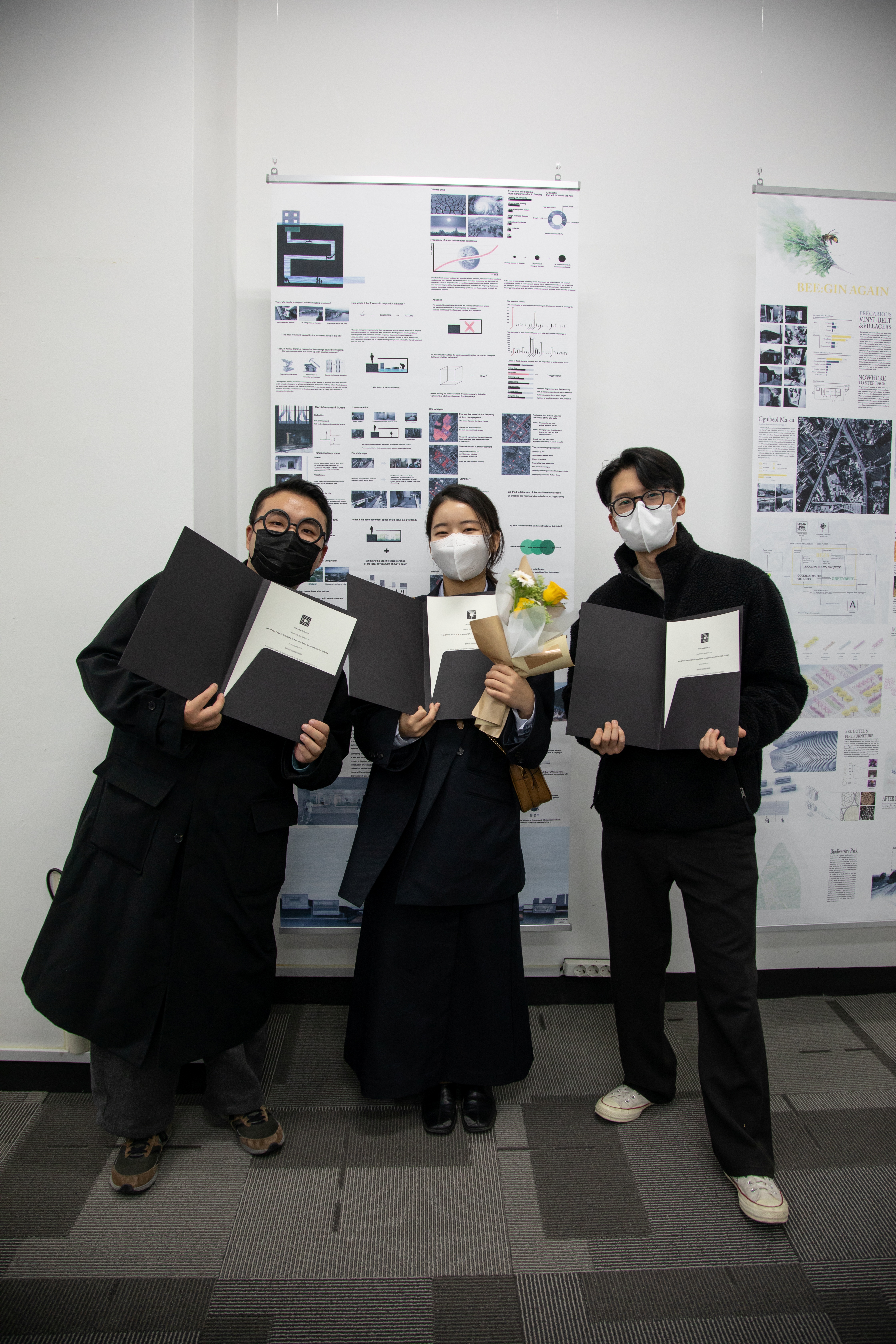
CHA, JAE HYEON
SUNG, JUNG HAN
KIM, SU RIN
Dong-A University
Wetlands in the city
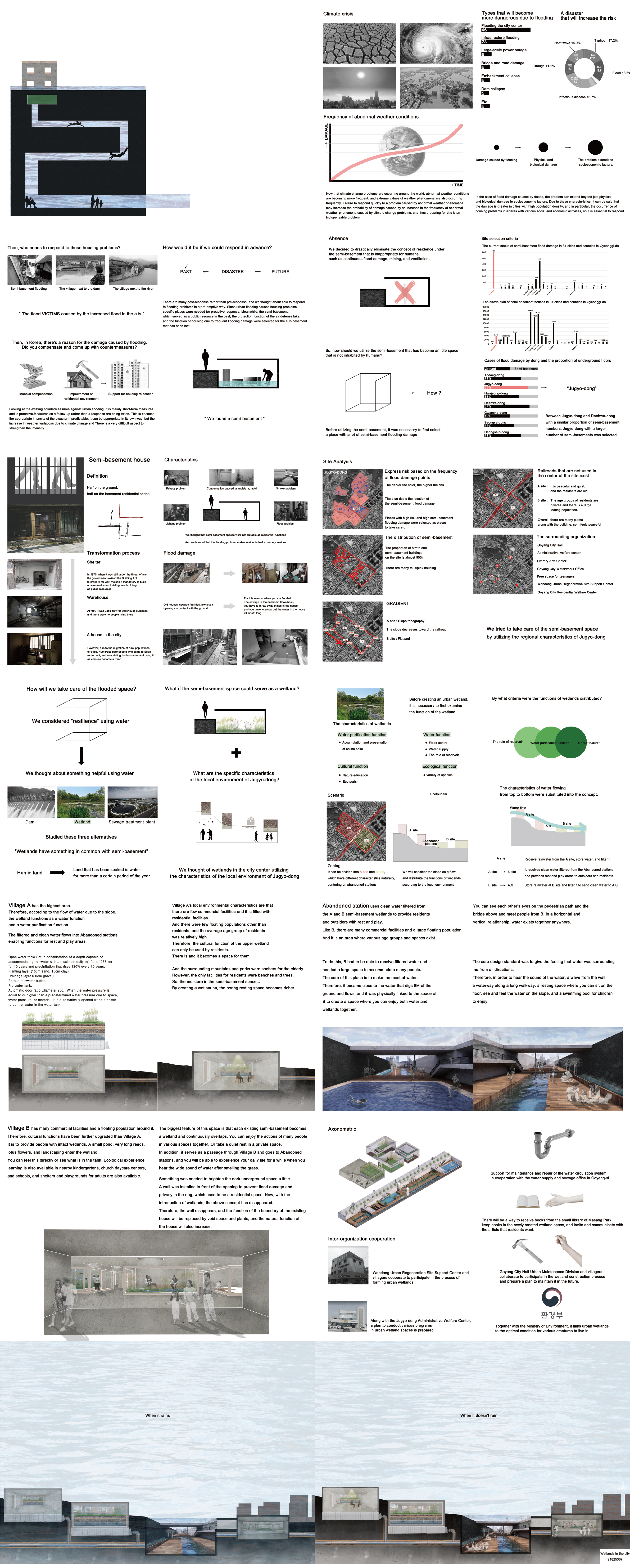
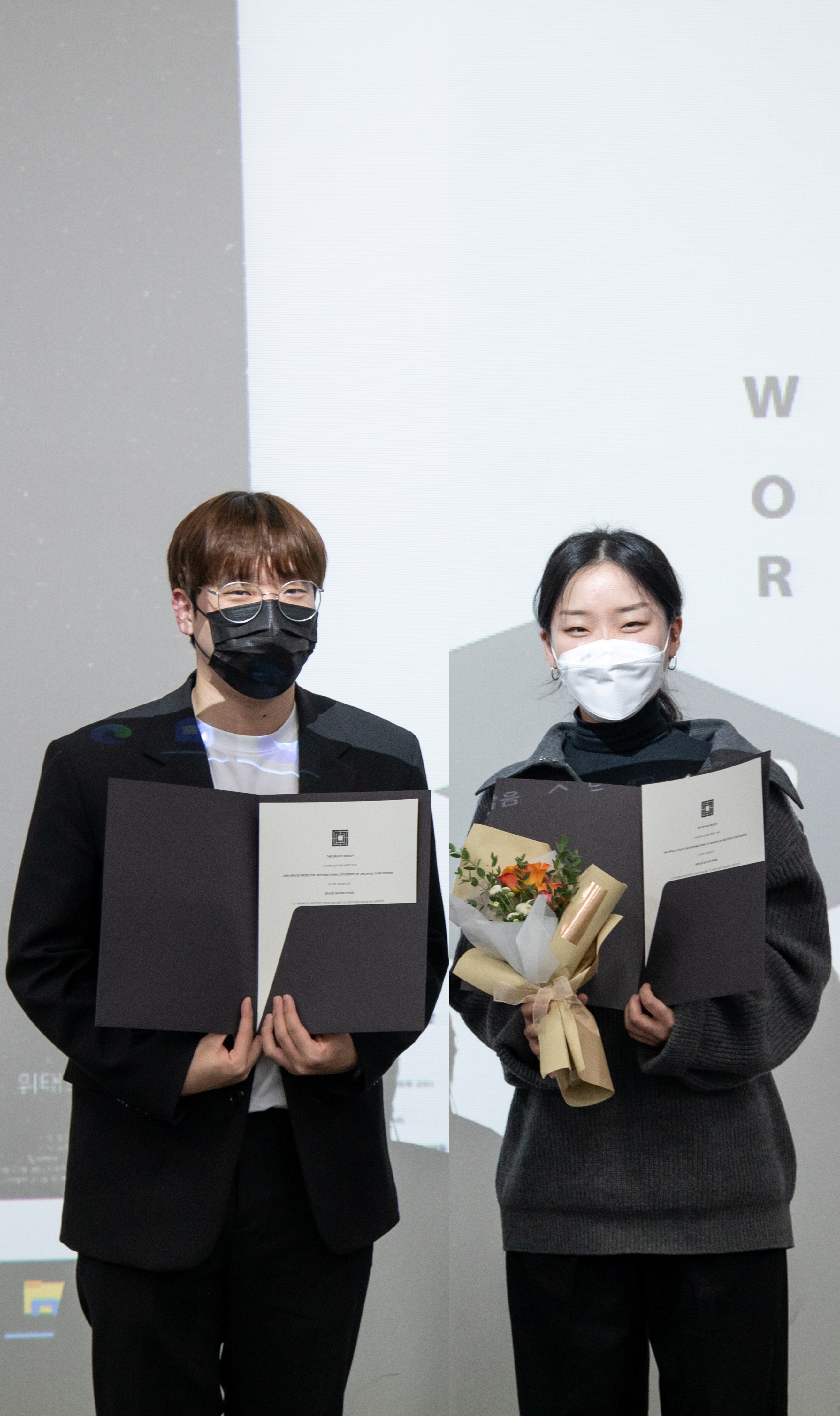
KIM, SU AN
JEONG, JAE HOON
Pukyong National University
Nomadic Architecture
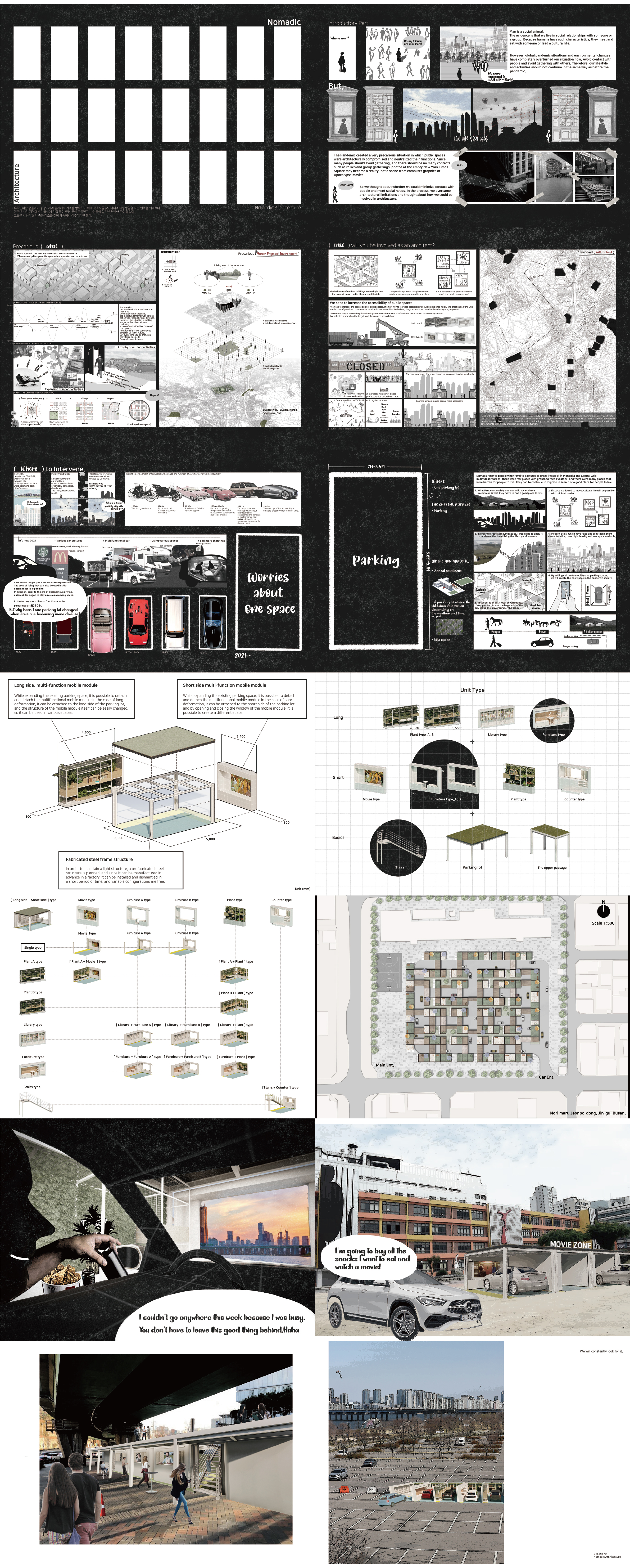
HONORABLE MENTION

KO, YU JEONG
PARK, SEONG UK
CHOI, JEE HYE
Myongji University
New Paradigm on The Block


HA, JU YEON
LEE, HYUN WOO
KIM, KI HWA
Keimyung University
수달 동화 : Otter Assimilation


LEE, HYUN KI
NOH, GEON WOO
BAE, DONG HYEUK
Yonsei University
No Country for Old Men


KIM, DONG HYUN
OH, SEUNG WON
LEE, JEONG YEOP
Kookmin University
BEE:GIN AGAIN


KOO, YE CHAN
HAN, YUN JEONG
KOO, SEUNG HYUN
Korea University
What if there's a RUIN?







